Temporal and Spatial Variations in the Thermal Front in the Beibu Gulf in Winter
Abstract
1. Introduction
2. Data and Methods
2.1. Data
2.2. Methods
2.2.1. Identification of the Thermal Fronts in the Beibu Gulf
2.2.2. Definition of Thermal Front Intensity in the Beibu Gulf
2.2.3. Definition of Differences in SSTs Between Shallow-Water and Deep-Water Areas in the Beibu Gulf
2.2.4. Method for Separating Interannual Variation and Trend Variation
3. Results
3.1. Formation Mechanism of the TFIBG
3.2. Seasonal Variation in the TFIBG
3.3. Interannual Variation in the TFIBG
3.4. Rising Trend of TFIBG
4. Discussion
5. Conclusions
Author Contributions
Funding
Data Availability Statement
Conflicts of Interest
References
- Shi, M.; Chen, B.; Zhang, J. Research status and prospect of runoff in the Beibu Gulf. Guangxi Sci. 2022, 29, 1026–1032. [Google Scholar] [CrossRef]
- Chen, Z.H. Numerical Simulation on Seasonal Variation of Ocean Circulation and Its Dynamic Mechanism in the Beibu Gulf. Ph.D. Thesis, Ocean University of China, Qingdao, China, 2013. [Google Scholar]
- Ding, Y. Investigation on the Circulation and Coastal Trapped Waves in the Northern South China Sea. Ph.D. Thesis, Ocean University of China, Qingdao, China, 2015. [Google Scholar]
- Chen, B.; Shi, M. Advances in study of Beibu Gulf circulation. Guangxi Sci. 2019, 26, 595–603. [Google Scholar]
- Chen, C.; Lai, Z.; Beardsley, R.C.; Xu, Q.; Lin, H.; Viet, N.T. Current Separation and Upwelling over the Southeast Shelf of Vietnam in the South China Sea. J. Geophys. Res. Ocean. 2012, 117, C03033. [Google Scholar] [CrossRef]
- Chen, D.; Liu, W.T.; Tang, W.; Wang, Z. Air-Sea Interaction at an Oceanic Front: Implications for Frontogenesis and Primary Production. Geophys. Res. Lett. 2003, 30, 1745. [Google Scholar] [CrossRef]
- Belkin, I.M.; Cornillon, P.C.; Sherman, K. Fronts in Large Marine Ecosystems. Prog. Oceanogr. 2009, 81, 223–236. [Google Scholar] [CrossRef]
- Belkin, I.M. Remote Sensing of Ocean Fronts in Marine Ecology and Fisheries. Remote Sens. 2021, 13, 883. [Google Scholar] [CrossRef]
- Huang, D.; Zhang, T.; Zhou, F. Sea-Surface Temperature Fronts in the Yellow and East China Seas from TRMM Microwave Imager Data. Deep Sea Res. Part II Top. Stud. Oceanogr. 2010, 57, 1017–1024. [Google Scholar] [CrossRef]
- Wang, Y.; Yu, Y.; Zhang, Y.; Zhang, H.-R.; Chai, F. Distribution and Variability of Sea Surface Temperature Fronts in the South China Sea. Estuar. Coast. Shelf Sci. 2020, 240, 106793. [Google Scholar] [CrossRef]
- Liu, D.; Lü, T.; Lin, L.; Wei, Q.-S. Review of Fronts and Its Ecological Effects in the Shelf Sea of China. Adv. Mar. Sci. 2022, 40, 725–741. [Google Scholar]
- Zhang, H.-R.; Yu, Y.; Gao, Z.; Zhang, Y.; Ma, W.; Yang, D.; Yin, B.; Wang, Y. Seasonal and Interannual Variability of Fronts and Their Impact on Chlorophyll-a in the Indonesian Seas. J. Phys. Oceanogr. 2023, 53, 2847–2859. [Google Scholar] [CrossRef]
- Jing, Z.; Qi, Y.; Du, Y.; Zhang, S.; Xie, L. Summer Upwelling and Thermal Fronts in the Northwestern South China Sea: Observational Analysis of Two Mesoscale Mapping Surveys. J. Geophys. Res. Oceans 2015, 120, 1993–2006. [Google Scholar] [CrossRef]
- Jing, Z.; Qi, Y.; Fox-Kemper, B.; Du, Y.; Lian, S. Seasonal Thermal Fronts on the Northern South China Sea Shelf: Satellite Measurements and Three Repeated Field Surveys. J. Geophys. Res. Oceans 2016, 121, 1914–1930. [Google Scholar] [CrossRef]
- Sun, R.; Li, P.; Zhai, F.; Gu, Y.; Bai, P. New Insight Into the Formation Mechanism of Wintertime Thermal Front West of Luzon Island. J. Geophys. Res. Oceans 2024, 129, e2023JC020774. [Google Scholar] [CrossRef]
- Zhang, L.; Sun, R.; Li, P.; Ye, G. Seasonal and Interannual Variabilities of the Thermal Front East of Gulf of Thailand. Front. Mar. Sci. 2024, 11, 1398791. [Google Scholar] [CrossRef]
- Wang, D.; Liu, Y.; Qi, Y.; Shi, P. Seasonal Variability of Thermal Fronts in the Northern South China Sea from Satellite Data. Geophys. Res. Lett. 2001, 28, 3963–3966. [Google Scholar] [CrossRef]
- Belkin, I.; Cornillon, P. SST Fronts of the Pacific Coastal and Marginal Seas. Pac. Oceanogr. 2003, 1, 90–113. [Google Scholar]
- Luo, L.; Wang, X.; Liu, Y.; Li, S. Seasonal and interannual variation of thermal fronts in Beibu Gulf, South China Sea. J. Trop. Oceanogr. 2003, 22, 60–67. [Google Scholar]
- Huang, B.; Liu, C.; Banzon, V.; Freeman, E.; Graham, G.; Hankins, B.; Smith, T.; Zhang, H.-M. Improvements of the Daily Optimum Interpolation Sea Surface Temperature (DOISST) Version 2.1. J. Clim. 2021, 34, 2923–2939. [Google Scholar] [CrossRef]
- Atlas, R.; Hoffman, R.N.; Ardizzone, J.; Leidner, S.M.; Jusem, J.C.; Smith, D.K.; Gombos, D. A Cross-Calibrated, Multiplatform Ocean Surface Wind Velocity Product for Meteorological and Oceanographic Applications. Bull. Am. Meteorol. Soc. 2011, 92, 157–174. [Google Scholar] [CrossRef]
- Mears, C.A.; Scott, J.; Wentz, F.J.; Ricciardulli, L.; Leidner, S.M.; Hoffman, R.; Atlas, R. A Near-Real-Time Version of the Cross-Calibrated Multiplatform (CCMP) Ocean Surface Wind Velocity Data Set. J. Geophys. Res. Oceans 2019, 124, 6997–7010. [Google Scholar] [CrossRef]
- Sun, R.; Ling, Z.; Chen, C.; Yan, Y. Interannual Variability of Thermal Front West of Luzon Island in Boreal Winter. Acta Oceanol. Sin. 2015, 34, 102–108. [Google Scholar] [CrossRef]
- Dohan, K. Ocean Surface Current Analyses Real-Time (OSCAR) Surface Currents—Near Real Time 0.25 Degree (Version 2.0). User’s Handbook; Earth and Space Research; PO.DAAC: Pasadena, CA, USA, 2021. [Google Scholar]
- Dohan, K.; Kao, H.-Y.; Lagerloef, G.S.E. The Freshwater Balance: Over the North Atlantic SPURS Domain from Aquarius Satellite Salinity, OSCAR Satellite Surface Currents, and Some Simplified Approaches. Oceanography 2015, 28, 86–95. [Google Scholar] [CrossRef][Green Version]
- Chang, Y.; Shieh, W.-J.; Lee, M.-A.; Chan, J.-W.; Lan, K.-W.; Weng, J.-S. Fine-Scale Sea Surface Temperature Fronts in Wintertime in the Northern South China Sea. Int. J. Remote Sens. 2010, 31, 4807–4818. [Google Scholar] [CrossRef]
- Lin, L.; Liu, D.; Luo, C.; Xie, L. Double Fronts in the Yellow Sea in Summertime Identified Using Sea Surface Temperature Data of Multi-Scale Ultra-High Resolution Analysis. Cont. Shelf Res. 2019, 175, 76–86. [Google Scholar] [CrossRef]
- Belkin, I.M.; Cornillon, P.C. Surface thermal fronts of the Okhotsk Sea. Pac. Oceanogr. 2004, 2, 6–19. [Google Scholar]
- Ullman, D.S.; Cornillon, P.C. Satellite-Derived Sea Surface Temperature Fronts on the Continental Shelf off the Northeast U.S. Coast. J. Geophys. Res. Oceans 1999, 104, 23459–23478. [Google Scholar] [CrossRef]
- Xie, S.-P.; Hafner, J.; Tanimoto, Y.; Liu, W.T.; Tokinaga, H.; Xu, H. Bathymetric Effect on the Winter Sea Surface Temperature and Climate of the Yellow and East China Seas. Geophys. Res. Lett. 2002, 29, 81-1–81-4. [Google Scholar] [CrossRef]
- Huang, D.; Fan, X.; Xu, D.; Tong, Y.; Su, J. Westward Shift of the Yellow Sea Warm Salty Tongue. Geophys. Res. Lett. 2005, 32, L24613. [Google Scholar] [CrossRef]
- Gao, J.; Shi, M.; Chen, B.; Guo, P.; Zhao, D. Responses of the Circulation and Water Mass in the Beibu Gulf to the Seasonal Forcing Regimes. Acta Oceanol. Sin. 2014, 33, 1–11. [Google Scholar] [CrossRef]
- Gao, J.; Chen, B.; Shi, M. Summer Circulation Structure and Formation Mechanism in the Beibu Gulf. Sci. China Earth Sci. 2015, 58, 286–299. [Google Scholar] [CrossRef]
- Chen, Z.; Qiao, F.; Xia, C.; Wang, G. The Numerical Investigation of Seasonal Variation of the Cold Water Mass in the Beibu Gulf and Its Mechanisms. Acta Oceanol. Sin. 2015, 34, 44–54. [Google Scholar] [CrossRef]
- Shi, M.; Chen, C.; Xu, Q.; Lin, H.; Liu, G.; Wang, H.; Wang, F.; Yan, J. The Role of Qiongzhou Strait in the Seasonal Variation of the South China Sea Circulation. J. Phys. Oceanogr. 2002, 32, 103–121. [Google Scholar] [CrossRef]
- Chen, B.; Xu, Z.; Ya, H.; Chen, X.; Xu, M. Impact of the Water Input from the Eastern Qiongzhou Strait to the Beibu Gulf on Guangxi Coastal Circulation. Acta Oceanol. Sin. 2019, 38, 1–11. [Google Scholar] [CrossRef]
- Chen, Y.; Song, D.; Wang, N.; Ding, Y.; Shi, M.; Chen, B.; Bao, X. Baroclinic Responses of Qiongzhou Strait Throughflow to Different Forcings. Estuar. Coast. Shelf Sci. 2024, 308, 108938. [Google Scholar] [CrossRef]
- Zheng, Q.; Wang, H.; Li, S.; Cao, Z.; Bao, M. Dynamics of Currents in the Qiongzhou Strait during Spring and Summer Based on a Numerical Simulation. Front. Mar. Sci. 2024, 11, 1367145. [Google Scholar] [CrossRef]
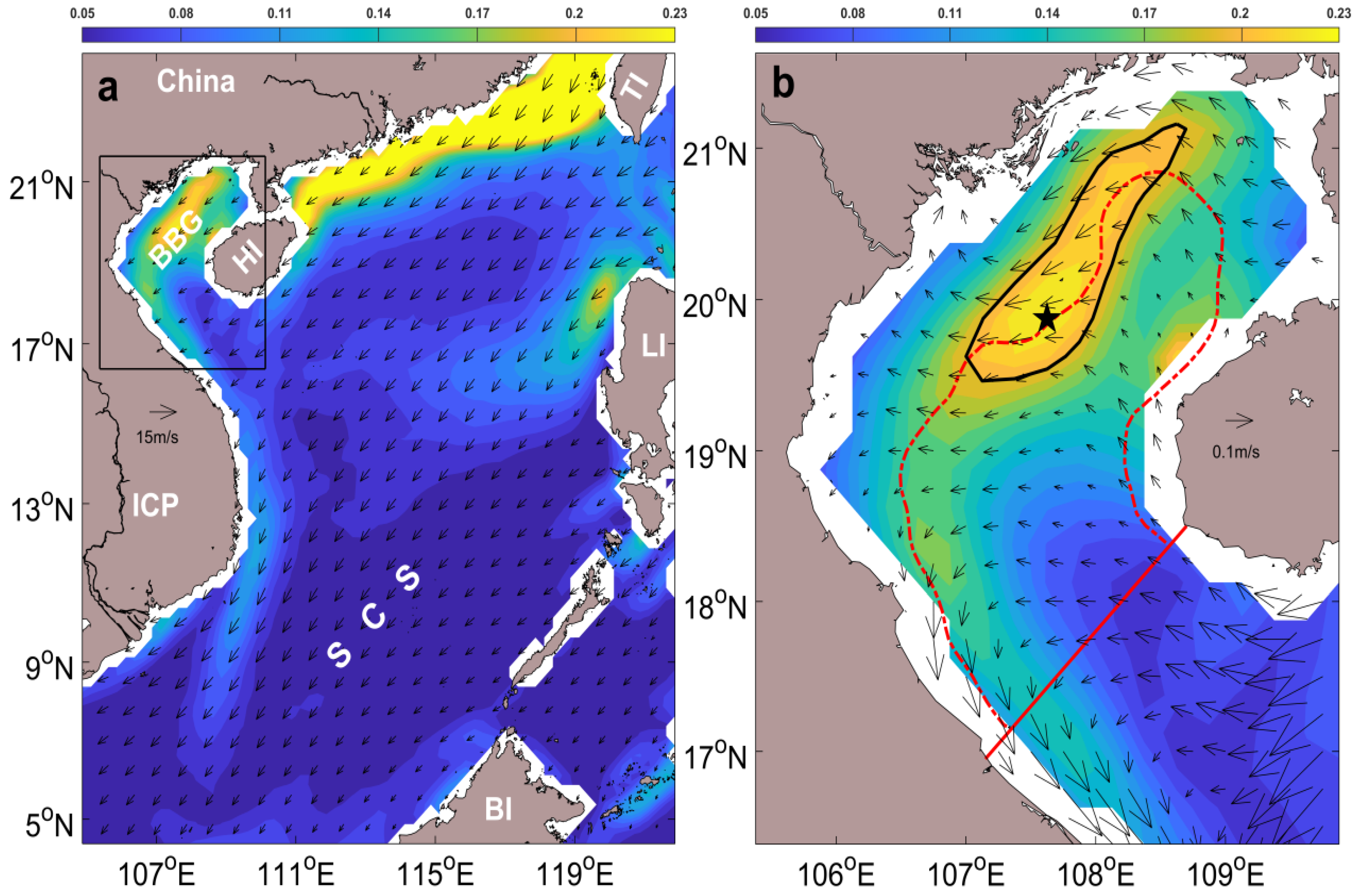
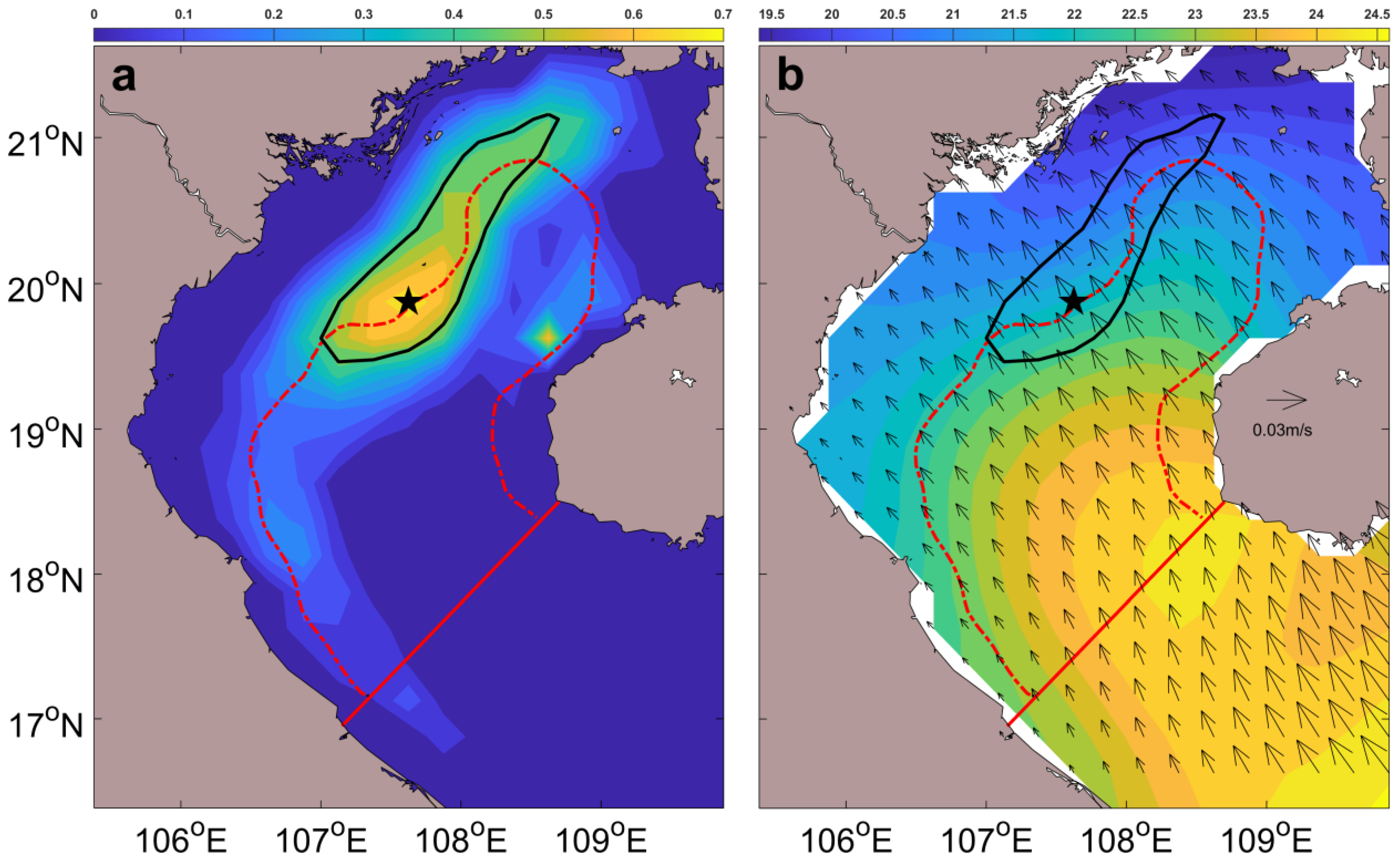
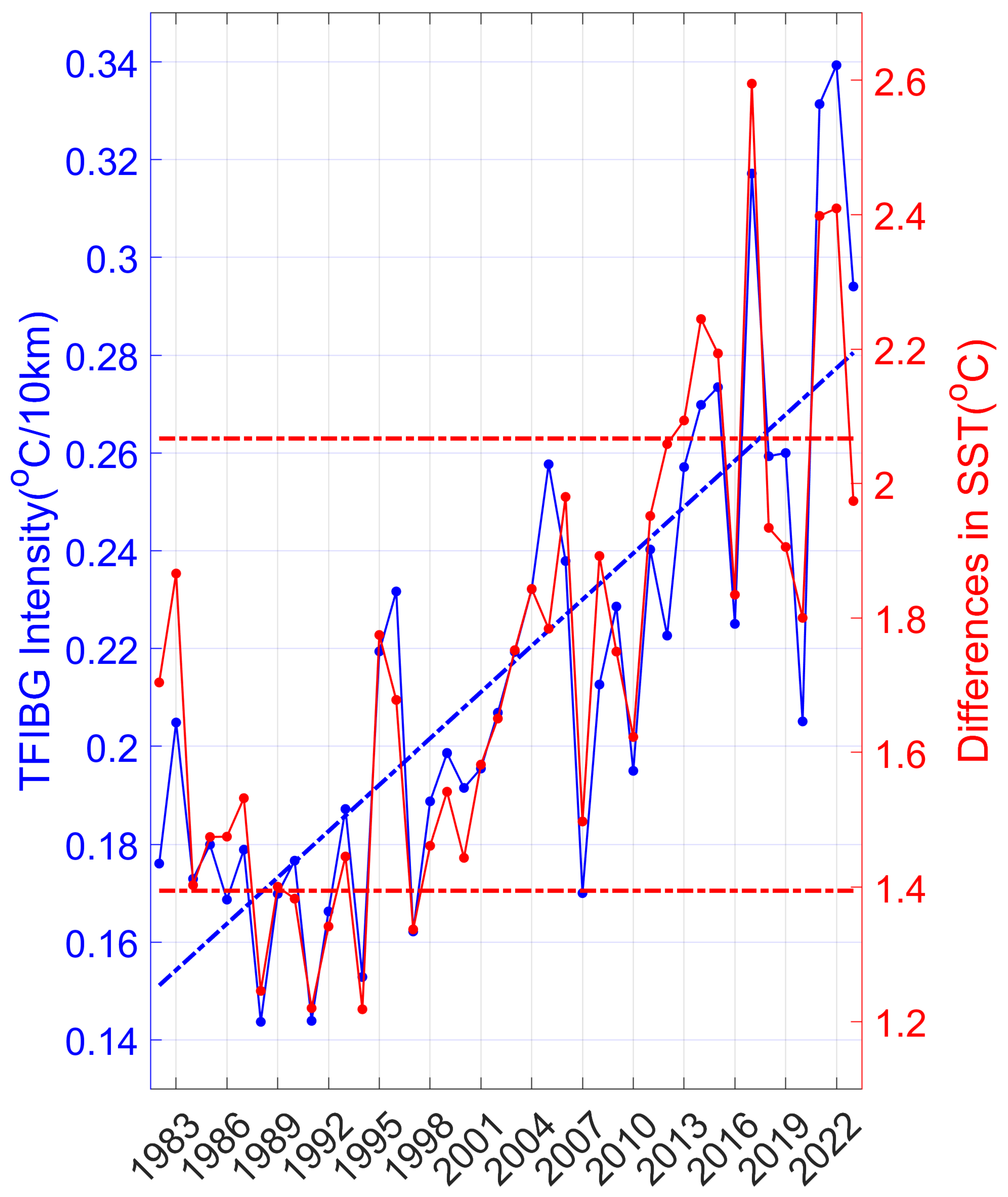
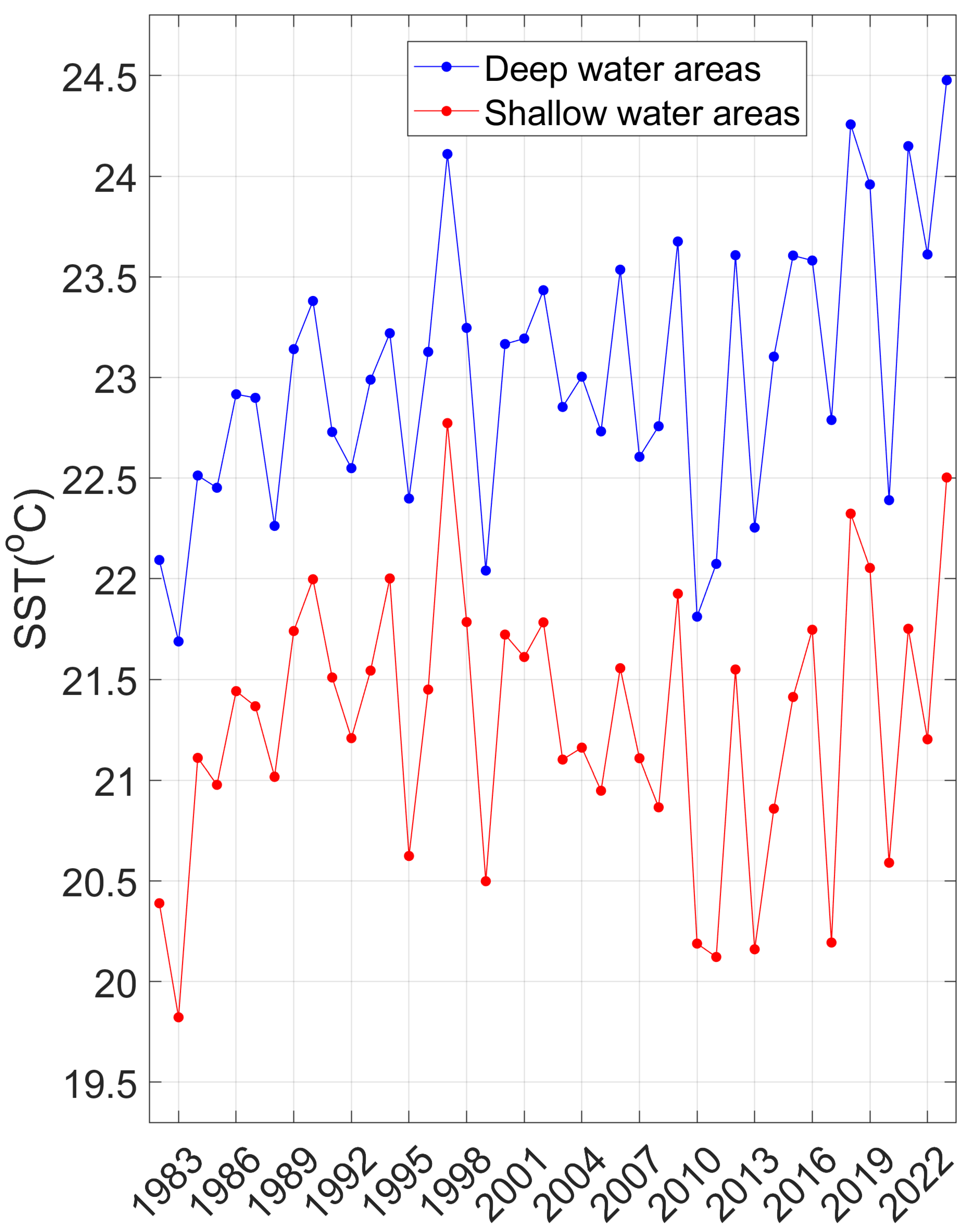
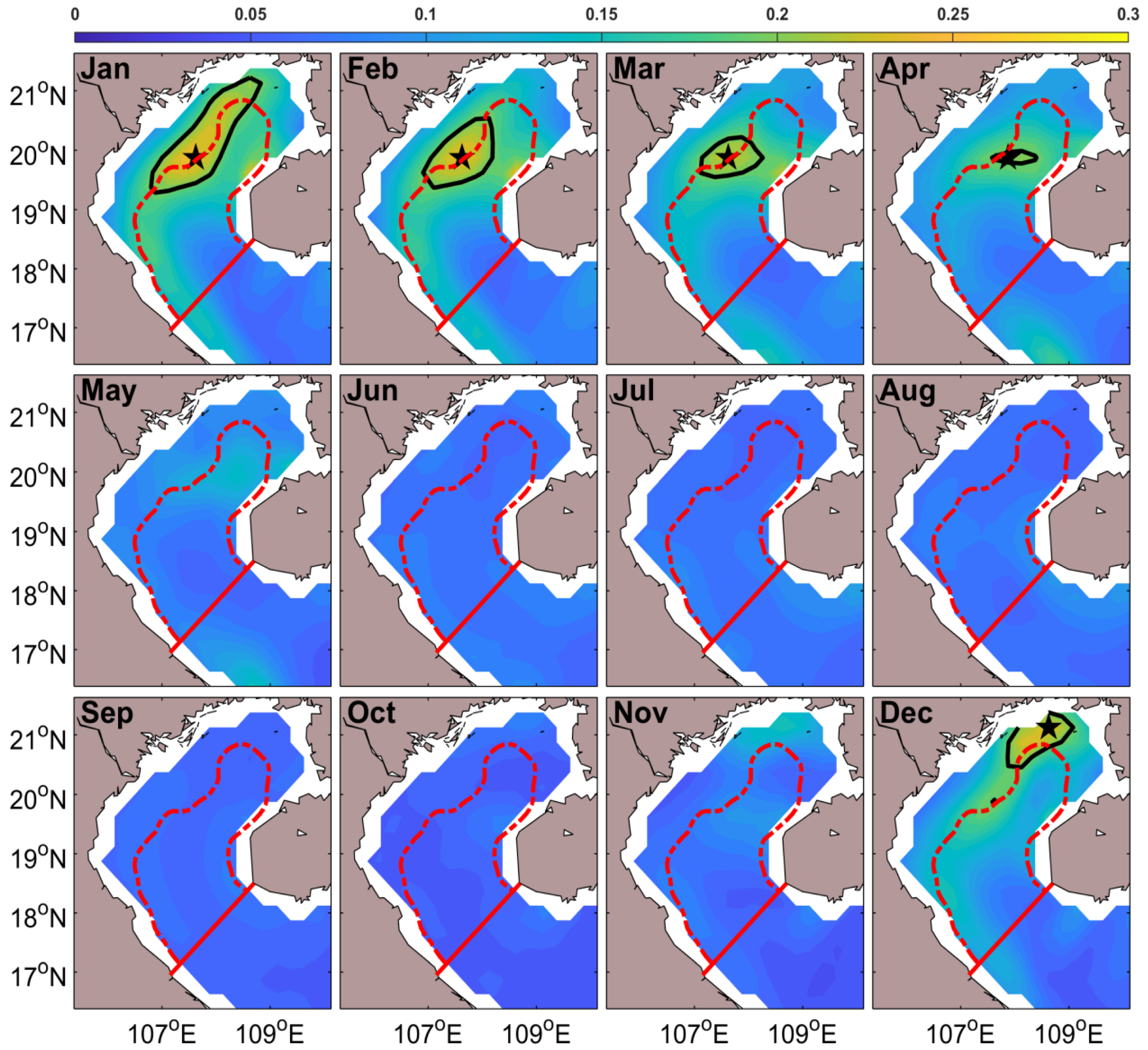

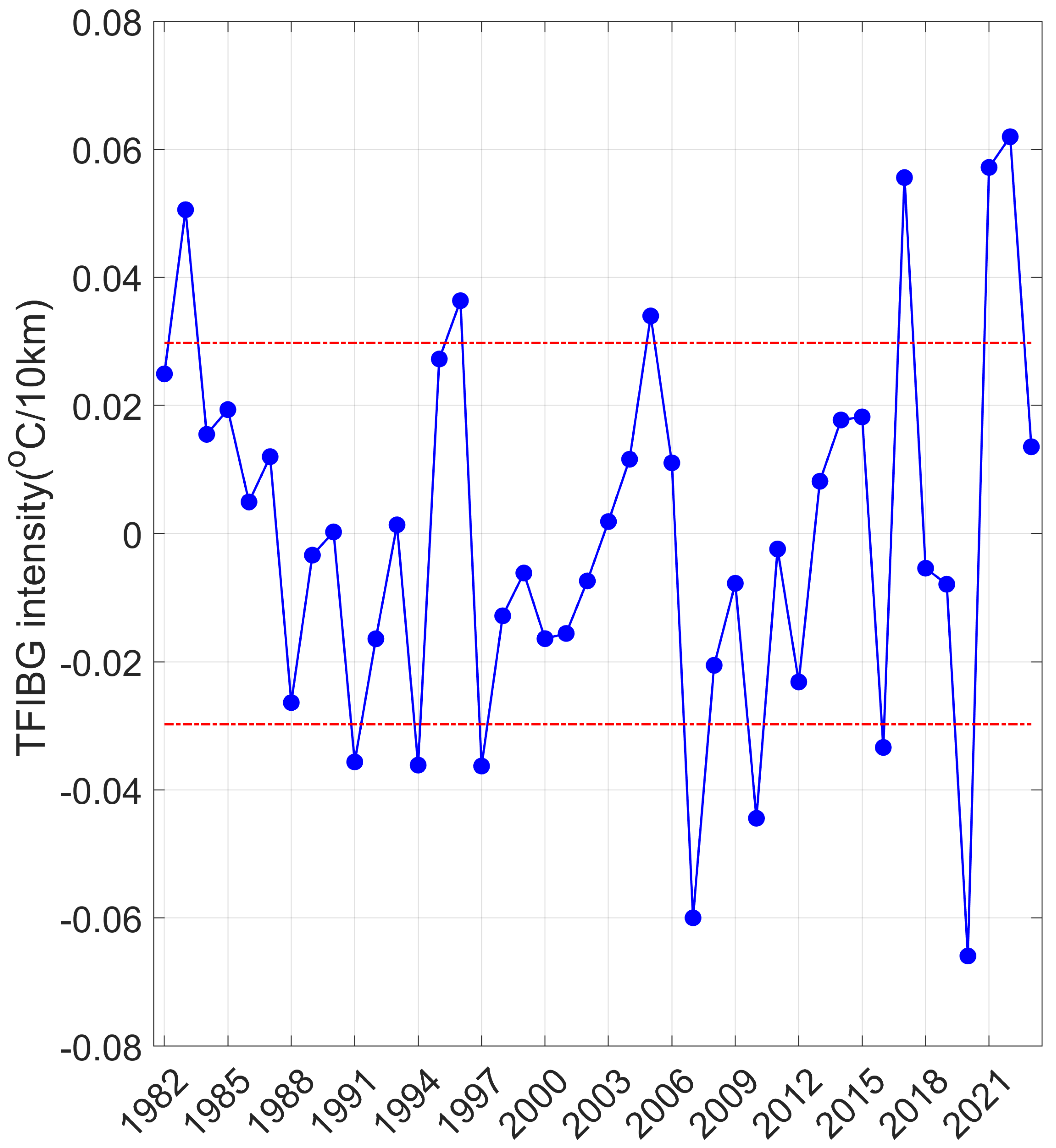

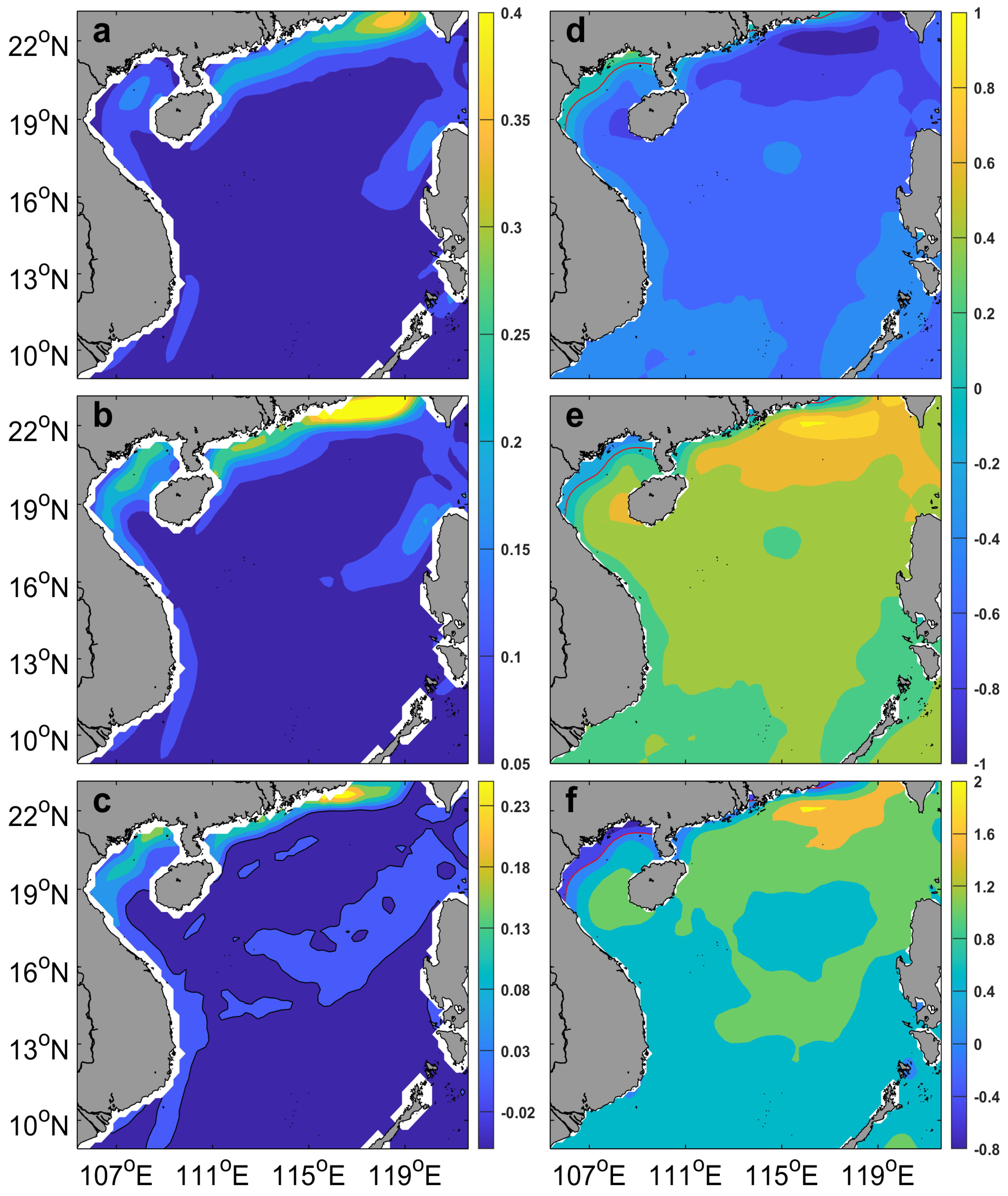
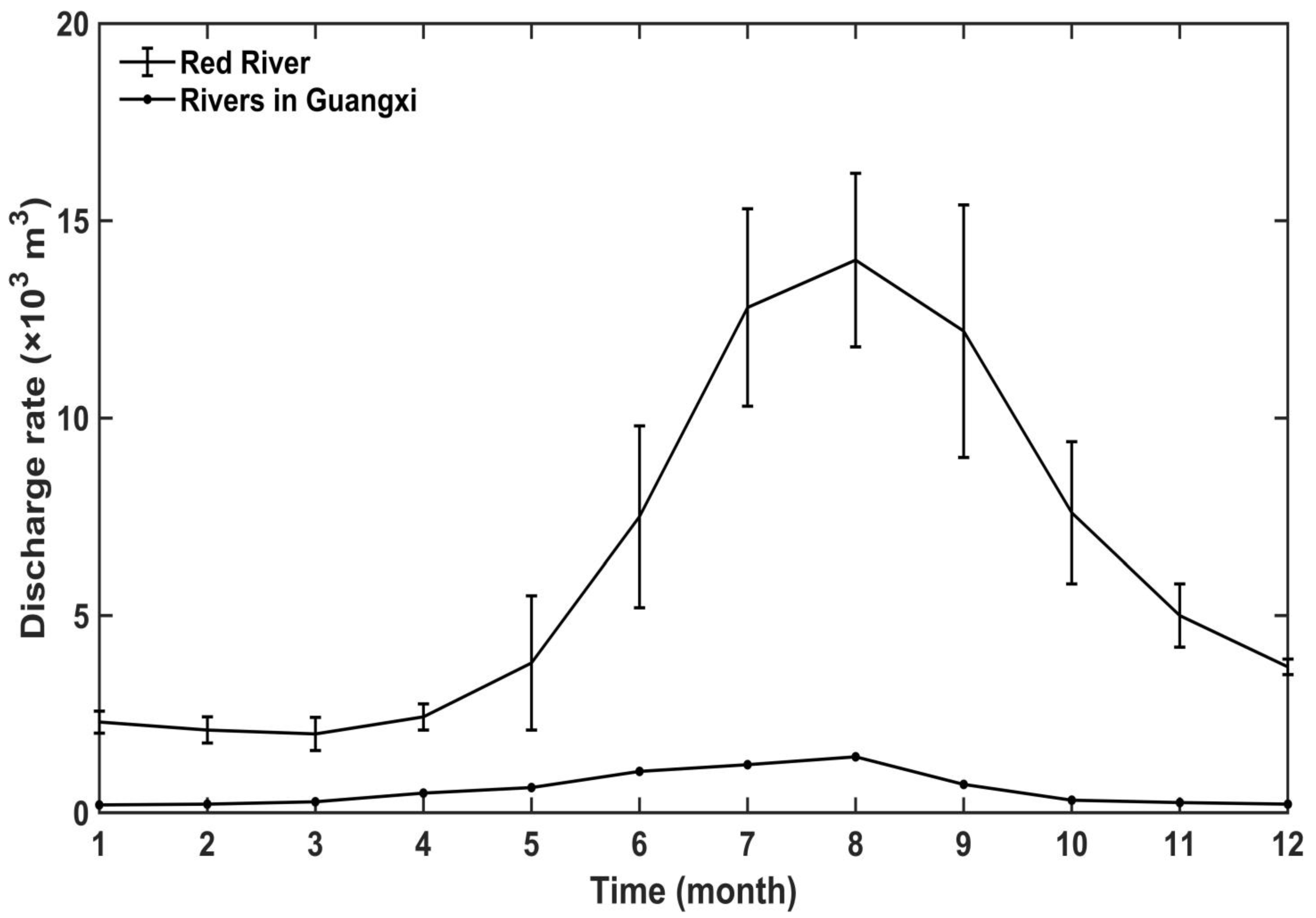
Disclaimer/Publisher’s Note: The statements, opinions and data contained in all publications are solely those of the individual author(s) and contributor(s) and not of MDPI and/or the editor(s). MDPI and/or the editor(s) disclaim responsibility for any injury to people or property resulting from any ideas, methods, instructions or products referred to in the content. |
© 2025 by the authors. Licensee MDPI, Basel, Switzerland. This article is an open access article distributed under the terms and conditions of the Creative Commons Attribution (CC BY) license (https://creativecommons.org/licenses/by/4.0/).
Share and Cite
Sun, R.; Song, X.; He, S.; Li, P.; Gu, Y.; Zhou, C. Temporal and Spatial Variations in the Thermal Front in the Beibu Gulf in Winter. Remote Sens. 2025, 17, 469. https://doi.org/10.3390/rs17030469
Sun R, Song X, He S, Li P, Gu Y, Zhou C. Temporal and Spatial Variations in the Thermal Front in the Beibu Gulf in Winter. Remote Sensing. 2025; 17(3):469. https://doi.org/10.3390/rs17030469
Chicago/Turabian StyleSun, Ruili, Xindi Song, Shuangyan He, Peiliang Li, Yanzhen Gu, and Chaojie Zhou. 2025. "Temporal and Spatial Variations in the Thermal Front in the Beibu Gulf in Winter" Remote Sensing 17, no. 3: 469. https://doi.org/10.3390/rs17030469
APA StyleSun, R., Song, X., He, S., Li, P., Gu, Y., & Zhou, C. (2025). Temporal and Spatial Variations in the Thermal Front in the Beibu Gulf in Winter. Remote Sensing, 17(3), 469. https://doi.org/10.3390/rs17030469






